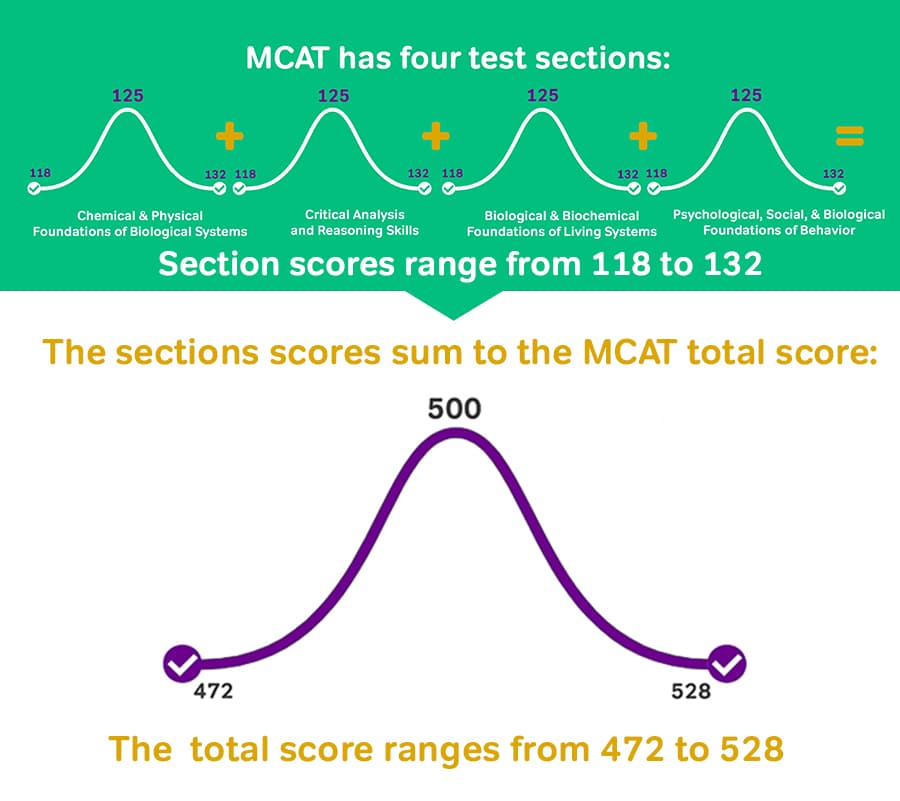If you’re reading this, chances are you’re interested in medical school–and you probably have some idea of how competitive that medical school admissions process is going to be. Just to begin the journey towards earning your M.D. or D.O. will require a foundation built on high MCAT scores and an impressive GPA.
But what exactly are the stats, including GPA and MCAT scores, that med schools want to see in a competitive applicant?

To help you get started, we’ve compiled the most recent MCAT scores and average undergraduate GPAs of students admitted to the top 100 medical schools in the United States.
Each responsive dot in the graph below represents one of the top 100 med schools in the United States. Hover over a dot to learn more about that program’s average MCAT scores and acceptance rates (and check the charts below for the average GPA of admitted students!). You can also drag and release your mouse over an area to zoom in, then right-click to reset the view!
About this graph: Each school is plotted by 50th percentile MCAT scores for accepted students (the y-axis) and acceptance rate (x-axis). The colors of the dots help you visualize where the schools are at in the U.S. News Top Med Schools rankings. For example, you can see that Wash U, a top 10 school with a very high 50th percentile MCAT score, actually has a higher acceptance rate than many other med schools.
Below, we’ll break down these numbers to help you get an idea of how your academic record stacks up against the competition–and where you should be aiming when setting your GPA and MCAT score goals.
Table of Contents
This post will answer the following questions:
- How are MCAT scores, percentiles, and GPA calculated?
- How important are MCAT scores and GPA in med school admissions?
- Is your MCAT score high enough?
- Is your GPA good enough?
- What are good MCAT scores for medical schools ranked in the top 100 nationwide?
- What’s a good GPA for medical schools ranked in the top 100 nationwide?
But before we dive into the facts and figures, let’s make sure we all understand the basics of MCAT scores and GPA.
How are MCAT scores, percentiles, and GPA calculated?
MCAT Scoring
In 2015 the Association of American Medical Colleges (AAMC) debuted a new version of the MCAT, making big changes to format, content, and (most notably for the purposes of this post) the score range.
On the old version of the MCAT, students were scored between 1-15 for each of the three sections, adding up to a perfect score of 45. With the addition of an entirely new fourth section on the revised MCAT, the AAMC chose to revamp the whole scoring system to avoid confusion (since a score in the 40’s certainly doesn’t mean the same thing now that you’re scoring out of 60).
The new system simply takes the old 15 point scale and adds 117 to each section. Now, instead of a 3-45 MCAT score range, students are scored between 118-132. So if you want a perfect score, you’ll be aiming for a 528.

Here’s a helpful graphic to help you visualize the score range:
How do percentiles work?
After taking the MCAT, you’ll be sent an MCAT score report, which will include not only your numeric score in each category but also your score percentile.
MCAT score percentiles measure where your score falls on the bell curve of everyone who’s taken the MCAT over the course of the same year as you.
In some ways, this percentile is more useful than your actual numerical MCAT score, because it shows you where you stand relative to your peers–after all, they’re the ones you’ll be competing with for acceptance slots.
You can find your percentiles in your score report, like this sample MCAT score report (PDF) shared by AAMC.
Do Medical Schools Recognize GPAs above 4.0?
GPA is calculated by dividing the amount of grade points you earn in a course by the course’s number of credit hours. Your grade point average may range from 0.0 to a 4.0. However, at several colleges (including Stanford, Columbia, and Cornell) students are allowed to earn A+ grades, which are scored as a 4.3.
But don’t let this worry you! The admissions committees at medical schools are aware that grading policies vary between institutions, and so they’ve come up with two standardized processes used for calculating the GPA of med school applicants–one for MD programs and one for DO programs–and both of these GPA adjustments factor out the added 0.3 grade point associated with an A+.
How do MD Programs Calculate GPA?
Med schools that focus on allelopathic medicine are the most common type of medical training institution, and graduates from these programs receive MDs at the end of their course of study.
The American Medical College Applications Service (AMCAS) a service through which students apply to MD programs in the United States, uses the following process:
“AMCAS will convert most standard undergraduate transcript grades to an AMCAS grades based on conversion information provided by the institutions. The AMCAS GPA provides the medical students with a standard way to compare each applicants background.”
AMCAS calculates two different GPAs (on a 4.0 scale) using the transcripts submitted by each applicant. The first is a cumulative GPA of all courses the applicant has taken. The second is a Science GPA–also called a BCPM GPA–which only counts grades from Biology, Chemistry, Physics, and Math courses. Both GPAs are used when considering an applicant’s academic record.
How do DO Programs Calculate GPA?
The second most common type of medical schools are DO programs, which focus on osteopathic medicine. Students can apply to schools that give DO degrees through the American Association of Colleges of Osteopathic Medicine Application Service (AACOMAS).
AACOMAS, like AMCAS, will recalculate applicants GPAs using a standardized 4.0 scale. Similar to AMCAS, AACOMAS calculates an overall GPA as well as a Science GPA–but the Science GPA does not include math classes, and does include more niche science classes such as zoology.
Unlike AMCAS, AACOMAS also calculates a GPA exclusively for non-science classes (though it does include courses in behavior science, such as psychology). In addition to this, AACOMAS calculates separate overall GPAs for each year of school applicants have attended on the undergraduate level or above, in order to track trends in students’ academic careers over time.

How important are MCAT scores and GPA?
The two most important pieces of your medical school application are your undergrad GPA and MCAT score.
There is still debate as to which of these two factors is more important, since different medical school admissions departments tend to place different emphasis on the various med school application requirements.
However, if you look at med school rankings, you’ll notice that a program’s rank tends to correlate more with admitted students’ MCAT scores than with their undergraduate GPAs. The top programs require a top MCAT score. And an excellent MCAT score can help compensate for a slightly lower GPA for med school. On the flip side, a low MCAT score won’t disqualify you–as long as your GPA is on the higher end!
Refer to the table below to see how GPA and MCAT scores work together with regard to admissions statistics.
Click to show the table
| Acceptance Rate for Applicants | Total MCAT Scores | |||||||||
| Less than 486 | 486-489 | 490-493 | 494-497 | 498-501 | 502-505 | 506-509 | 510-513 | 514-517 | 517+ | |
| Total GPA | Acceptance Rate % | |||||||||
| 3.80-4.00 | 1.3 | 1.7 | 6.6 | 18.2 | 29.7 | 43.7 | 59.2 | 73.2 | 80.5 | 86.6 |
| 3.60-3.79 | 1.1 | 1.2 | 4.6 | 11.3 | 23.0 | 32.3 | 46.4 | 62.1 | 72.2 | 78.6 |
| 3.40-3.59 | 0.8 | 1.5 | 3.2 | 10.0 | 18.2 | 25.6 | 36.0 | 49.5 | 61.1 | 69.7 |
| 3.20-3.39 | 0.4 | 0.9 | 2.3 | 7.1 | 14.3 | 21.8 | 29.2 | 40.3 | 49.0 | 56.7 |
| 3.00-3.19 | 0.5 | 0.6 | 1.9 | 6.0 | 13.8 | 20.7 | 25.9 | 33.5 | 43.3 | 54.3 |
| 2.80-2.99 | 0.7 | 0.6 | 1.7 | 3.9 | 11.0 | 17.0 | 21.5 | 26.3 | 30.7 | 45.2 |
| 2.60-2.79 | 0.0 | 1.6 | 0.9 | 4.7 | 10.6 | 15.2 | 21.2 | 23.4 | 37.3 | 18.8 |
| 2.40-2.59 | 0.0 | 0.0 | 1.7 | 3.2 | 5.4 | 10.0 | 23.4 | 23.7 | 33.3 | |
| 2.20-2.39 | 0.0 | 0.0 | 0.0 | 3.3 | 11.6 | 11.1 | 16.1 | 13.6 | ||
| 2.00-2.19 | 0.0 | 0.0 | 0.0 | 0.0 | 4.2 | 7.7 | 16.7 | 0.0 | 0.0 | 0.0 |
| Less than 2.00 | 0.0 | 0.0 | ||||||||
Table from AAMC (2021 PDF).
For more information on how MCAT scores are weighted in the med school admissions process, you can check out the AAMC’s guide to Using MCAT Data in 2021 Medical Student Selection (PDF).

Is your MCAT score high enough?
The 25th Percentile
If your MCAT score falls into a med school’s 25th percentile range, that means your score was better than the scores of 25% of that school’s recently admitted students–which also means that 75% of recently admitted students scored higher than you did.
Falling into a med school’s bottom 25th percentile means your MCAT score is not competitive for this program. While a 25th percentile score in no way disqualifies you from admissions–after all, a quarter of admitted students scored the same or lower!–it may be a good idea for you to retake the MCAT if the med school in question is your first choice institution.
Long story short, any med school where your MCAT score puts you in the 25% percentile is a reach school for you.
The 50th Percentile: Average MCAT Score
Your score is the median for this med school.
If you score within a school’s 50th percentile, then your MCAT score is pretty good. There’s a realistic chance that you’ll be accepted into this program. At this point, other components of your application (like your GPA, recommendation letters, personal statement, and work experience) are now very important. If you’ve scored in the 50th percentile and you don’t plan to take the MCAT again, spend your time and energy making the rest of your application as strong as it can possibly be.
Med schools where you’ve cracked the 50% percentile are your target schools–apply to several.
The 75th Percentile
A 75th percentile score means that you performed as well or better than 75% of the school’s newly admitted class, and your chances of admission are very high.
In fact, if your score falls above the 75th percentile of your dream school you have a good chance of consideration (unless we’re talking a top ten school, in which case things are still insanely competitive!) and you should consider applying to some higher ranked schools. There’s nothing wrong with having a reach school or two.
Also remember that the rest of your application is still important–and we’ll talk more about GPA for med school in a later section–even when your MCAT score is extremely competitive. A weak application can still derail your admissions chances. But an MCAT score in the 75th percentile definitely gives your application a very strong base to build on! (For more on this, check out our post “What is a Good MCAT Score?“).

Is your GPA good enough?
It probably comes as no surprise that the medical school admissions process is incredibly competitive when it comes to GPA.
Undergrads are generally expected to maintain, at the very least, a GPA of 3.5 or higher if they want a shot at acceptance into a top-tier program. And grades earned in science courses will be especially scrutinized, so that’s where you’ll want to be working extra hard to pull in the A’s.
Aiming for a GPA at least as high as the average GPA of students admitted to your school of choice is a good rule of thumb. Keep reading for GPA data on specific med schools, and see how you measure up!
MCAT scores and GPAs for the top 100 Medical Schools
The table below shows the top 100 medical schools in the United States for research (as ranked by US News), the 50th percentile MCAT scores and GPAs of each school’s most recently admitted students, and this year’s acceptance rate. Click the arrows by each column title to sort the table according to that category!
| Med School Rank | Med School Names | MCAT Score 50th Percentile | Average GPA | Acceptance Rate |
|---|---|---|---|---|
| 1 | Harvard University | 520 | 3.95 | 2.8% |
| 2 | Johns Hopkins University | 521 | 3.96 | 6.3% |
| 3 | University of Pennsylvania (Perelman) | 522 | 3.95 | 3.8% |
| 4 | Columbia University | 521 | 3.91 | 3.6% |
| 5 (tie) | Duke University | 518 | 3.86 | 2.9 |
| 5 (tie) | Stanford University | 517 | 3.89 | 1.4% |
| 5 (tie) | University of California–San Francisco | 515 | 3.87 | 2.8% |
| 5 (tie) | Vanderbilt University | 521 | 3.95 | 4.5% |
| 5 (tie) | Washington University in St. Louis | 521 | 3.9 | 7.5% |
| 10 (tie) | Cornell University (Weill) | 519 | 3.9 | 3.4% |
| 10 (tie) | New York University (Grossman) | N/A | N/A | 2.1% |
| 10 (tie) | Yale University | 521 | 3.9 | 5.7% |
| 13 (tie) | Mayo Clinic School of Medicine (Alix) | 521 | 3.94 | 4.5% |
| 13 (tie) | Northwestern University (Feinberg) | 520 | 3.92 | 4.9% |
| 13 (tie) | University of Michigan–Ann Arbor | 516 | 3.84 | 3.6% |
| 13 (tie) | University of Pittsburgh | 517 | 3.84 | 4.2% |
| 13 (tie) | University of Washington | 512 | 3.7 | 4.5% |
| 18 (tie) | Icahn School of Medicine at Mount Sinai | 517 | 3.84 | 3.4% |
| 18 (tie) | University of California– Los Angeles | 512 | 3.74 | 2.9% |
| 18 (tie) | University of Chicago (Pritzker) | 521 | 3.92 | 3.2% |
| 21 | University of California–San Diego | 515 | 3.83 | 3.4% |
| 22 | Baylor College of Medicine | 518 | 3.9 | 5.1% |
| 23 | Emory University | 514 | 3.71 | 3.3% |
| 24 | University of Texas Southwestern Medical Center | 517 | 3.94 | 9.7% |
| 25 | Case Western Reserve University | 518 | 3.87 | 6.5% |
| 26 (tie) | University of Colorado | 514 | 3.73 | 5.4% |
| 26 (tie) | University of North Carolina–Chapel Hill | 512 | 3.68 | 4.2% |
| 28 (tie) | Ohio State University | 514 | 3.88 | 6% |
| 28 (tie) | University of Southern California (Keck) | 518 | 3.82 | 4% |
| 30 (tie) | Oregon Health and Science University | 511 | 3.69 | 3.8% |
| 30 (tie) | University of Virginia | 519 | 3.87 | 10% |
| 32 (tie) | Boston University | 517 | 3.79 | 4.1% |
| 32 (tie) | University of Maryland | 513 | 3.8 | 5% |
| 32 (tie) | University of Rochester | 517 | 3.85 | 5.6% |
| 35 (tie) | Brown University (Alpert) | 515 | 3.8 | 2.8% |
| 35 (tie) | University of Alabama – Birmingham | 509 | 3.85 | 5.8% |
| 35 (tie) | University of Cincinnati | 516 | 3.72 | 6.6% |
| 35 (tie) | University of Florida | 515 | 3.86 | 4.1% |
| 35 (tie) | University of Minnesota | 511 | 3.8 | 7.4% |
| 35 (tie) | University of Utah | 512 | 3.76 | 4.3% |
| 35 (tie) | University of Wisconsin–Madison | 511 | 3.68 | 5.1% |
| 42 (tie) | Albert Einstein College of Medicine | 516 | 3.85 | 3.8% |
| 42 (tie) | Indiana University–Indianapolis | 512 | 3.9 | 8.6% |
| 44 (tie) | University of California – Irvine | 516 | 3.83 | 3.4% |
| 44 (tie) | University of Iowa (Carver) | 513 | 3.79 | 7.7% |
| 44 (tie) | University of Massachusetts–Worcester | 515 | 3.76 | 7.4% |
| 44 (tie) | University of Miami (Miller) | 515 | 3.76 | 3.1% |
| 48 (tie) | Dartmouth College (Geisel) | 515 | 3.77 | 2.9% |
| 48 (tie) | Wake Forest University | 511 | 3.76 | 2.4% |
| 50 (tie) | University of California–Davis | 509 | 3.58 | 3.1% |
| 50 (tie) | University of South Florida | 518 | 3.91 | 8% |
| 50 (tie) | University of Texas Health Science Center–San Antonio | 518 | 3.9 | 7.4% |
| 53 (tie) | Georgetown University | 512 | 3.69 | 2.4% |
| 53 (tie) | Tufts University | 514 | 3.74 | 4.5% |
| 53 (tie) | University of Connecticut | 512 | 3.81 | 5.4% |
| 56 (tie) | Medical University of South Carolina | 511 | 3.8 | 15.7 |
| 56 (tie) | University of Texas Health Science Center–Houston (McGovern) | 512 | 3.84 | 4.5% |
| 58 (tie) | George Washington University | 512 | 3.73 | 2.5% |
| 58 (tie) | Stony Brook University–SUNY | 515 | 3.86 | 8.1% |
| 58 (tie) | Thomas Jefferson University (Kimmel) | 514 | 3.78 | 3.9% |
| 58 (tie) | University of Illinois | 511 | 3.73 | 7.8% |
| 58 (tie) | University of Nebraska | 511 | 3.81 | 10% |
| 63 | University of Arizona–Tucson | 510 | 3.77 | 2.6% |
| 64 (tie) | Texas A&M University | 511 | 3.73 | 5.4% |
| 64 (tie) | University of Kentucky | 505 | 3.84 | 7.2% |
| 64 (tie) | University of Vermont (Larner) | 512 | 3.74 | 4.8% |
| 64 (tie) | Virginia Commonwealth University | 512 | 3.77 | 4.9% |
| 68 (tie) | Hofstra University | 518 | 3.85 | 8.3% |
| 68 (tie) | Rush University | 510 | 3.6 | 3.1% |
| 68 (tie) | Rutgers Robert Wood Johnson Medical School–New Brunswick | 512 | 3.73 | 5.2% |
| 71 (tie) | Rutgers New Jersey Medical School–Newark | 513 | 3.68 | 5.7% |
| 71 (tie) | Temple University (Katz) | 512 | 3.78 | 5.3% |
| 71 (tie) | University of Tennessee Health Science Center | 512 | 3.88 | 9.5% |
| 71 (tie) | Wayne State University | 512 | 3.83 | 8.7% |
| 75 (tie) | University of Kansas Medical Center | 508 | 3.68 | 10.6% |
| 76 (tie) | University at Buffalo–SUNY (Jacobs) | 511 | 3.7 | 6.8% |
| 76 (tie) | University of Arkansas for Medical Sciences | 508 | 3.81 | 15.9% |
| 76 (tie) | University of Oklahoma | 509 | 3.89 | 10.5% |
| 79 (tie) | Augusta University | 513 | 3.86 | 10.7% |
| 79 (tie) | Hackensack Meridian School of Medicine | 514 | 3.83 | 6.6% |
| 81 (tie) | University of Hawaii–Manoa (Burns) | 512 | 3.74 | 3.7% |
| 81 (tie) | University of Louisville | 507 | 3.68 | 5.8% |
| 81 (tie) | University of New Mexico | 505 | 3.72 | 8.8% |
| 81 (tie) | Virginia Tech Carilion School of Medicine | 510 | 3.59 | 2% |
| 85 (tie) | Saint Louis University | 512 | 3.91 | 6.5% |
| 85 (tie) | University of Missouri | 510 | 3.78 | 6.3% |
| 87 | West Virginia University | 511 | 3.8 | 3.8% |
| 88 (tie) | Drexel University | 512 | 3.74 | 6.1% |
| 88 (tie) | Michigan State University College of Human Medicine (Broad) | 508 | 3.7 | 3.5% |
| 88 (tie) | SUNY Upstate Medical University | 511 | 3.71 | 7.5% |
| 88 (tie) | University of Missouri–Kansas City | 509 | 3.87 | 10.2% |
| 92 | New York University–Long Island | 516 | 3.84 | 1.2% |
| 93 | Geisinger Commonwealth School of Medicine | 512 | 3.76 | 7.9% |
| 94 (tie) | University of Nevada–Reno | 507 | 3.73 | 5.8% |
| 94 (tie) | University of South Carolina | 508 | 3.75 | 6.7% |
| 96 (tie) | Texas Tech University Health Sciences Center | 509 | 3.84 | 5.1% |
| 96 (tie) | University of California–Riverside | 508 | 3.67 | 2.3% |
| 98 (tie) | Florida State University | 506 | 3.79 | 4% |
| 98 (tie) | University of Central Florida | 515 | 3.89 | 5.5% |
| 100 | Eastern Virginia Medical School | 512 | 3.6 | 3.9% |

What’s a good MCAT score for medical schools ranked in the top 100 nationwide?
For the top 100 medical schools, the 50th percentile of MCAT scores for accepted students ranges from 505 to 522, with a median of 514. For the top 10 schools the range is shifted up, from 515 to 522, with a median of 519.
Depending on which med schools you’re looking at, you’re probably going to want to aim for an MCAT score in the upper teens or higher in order to be competitive for the top med programs.

What’s a good GPA for medical schools ranked in the top 100 nationwide?
For the top 100 medical schools, the average GPA for accepted students ranges from 3.58 to 3.96, with a median GPA of 3.77. For the top 10 schools, that range moves up: from 3.86 to 3.96, with a median of 3.88.
This means that 3.58 is really around the bottom limit of where your undergraduate GPA can be if you’re applying to any of the top 100 programs. You’ll be in much better shape if you can raise GPA up to a 3.75–and if you’re looking at the very top tier of medical school, you should be aiming for as close to a 4.0 as possible!
Takeaway
MCAT scores and GPA are the two biggest factors in determining your acceptance to med school.
And while it takes years of hard work to cultivate and maintain your GPA for med school, your MCAT scores are something you have much more short term control over–so you should definitely invest a whole lot of time and effort into your MCAT prep plan.
Depending how much time you have before you plan on taking the exam, check out our MCAT study plans:
The med school application process is challenging in terms of the time, effort, and money (not to mention medical school tuition) involved. That’s why we want to help with a variety of free and affordable MCAT prep resources. If you’re serious about med school, we recommend you invest in Magoosh MCAT prep and MCAT books or other resources to ensure your hard work pays off. You won’t regret it!
Please let us know if you have any questions, additions, or suggestions by leaving a comment on this post. We’d be thrilled to start a conversation with you.
The content of this post has been reviewed and approved by MCAT expert, Dr. Kat Thompson.






Leave a Reply